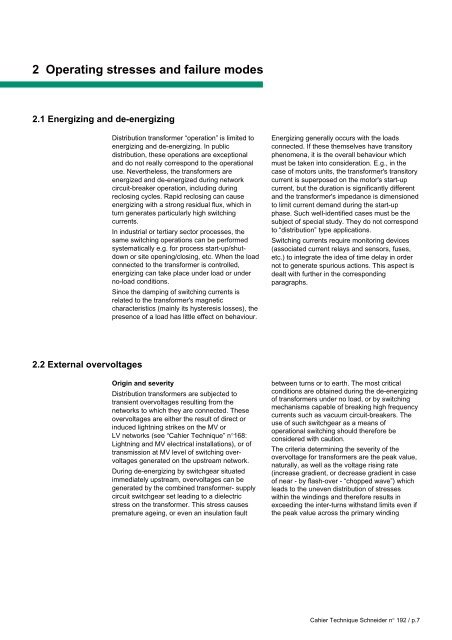ECT192
Create successful ePaper yourself
Turn your PDF publications into a flip-book with our unique Google optimized e-Paper software.
2 Operating stresses and failure modes<br />
2.1 Energizing and de-energizing<br />
Distribution transformer “operation” is limited to<br />
energizing and de-energizing. In public<br />
distribution, these operations are exceptional<br />
and do not really correspond to the operational<br />
use. Nevertheless, the transformers are<br />
energized and de-energized during network<br />
circuit-breaker operation, including during<br />
reclosing cycles. Rapid reclosing can cause<br />
energizing with a strong residual flux, which in<br />
turn generates particularly high switching<br />
currents.<br />
In industrial or tertiary sector processes, the<br />
same switching operations can be performed<br />
systematically e.g. for process start-up/shutdown<br />
or site opening/closing, etc. When the load<br />
connected to the transformer is controlled,<br />
energizing can take place under load or under<br />
no-load conditions.<br />
Since the damping of switching currents is<br />
related to the transformer's magnetic<br />
characteristics (mainly its hysteresis losses), the<br />
presence of a load has little effect on behaviour.<br />
Energizing generally occurs with the loads<br />
connected. If these themselves have transitory<br />
phenomena, it is the overall behaviour which<br />
must be taken into consideration. E.g., in the<br />
case of motors units, the transformer's transitory<br />
current is superposed on the motor's start-up<br />
current, but the duration is significantly different<br />
and the transformer's impedance is dimensioned<br />
to limit current demand during the start-up<br />
phase. Such well-identified cases must be the<br />
subject of special study. They do not correspond<br />
to “distribution” type applications.<br />
Switching currents require monitoring devices<br />
(associated current relays and sensors, fuses,<br />
etc.) to integrate the idea of time delay in order<br />
not to generate spurious actions. This aspect is<br />
dealt with further in the corresponding<br />
paragraphs.<br />
2.2 External overvoltages<br />
Origin and severity<br />
Distribution transformers are subjected to<br />
transient overvoltages resulting from the<br />
networks to which they are connected. These<br />
overvoltages are either the result of direct or<br />
induced lightning strikes on the MV or<br />
LV networks (see “Cahier Technique” n°168:<br />
Lightning and MV electrical installations), or of<br />
transmission at MV level of switching overvoltages<br />
generated on the upstream network.<br />
During de-energizing by switchgear situated<br />
immediately upstream, overvoltages can be<br />
generated by the combined transformer- supply<br />
circuit switchgear set leading to a dielectric<br />
stress on the transformer. This stress causes<br />
premature ageing, or even an insulation fault<br />
between turns or to earth. The most critical<br />
conditions are obtained during the de-energizing<br />
of transformers under no load, or by switching<br />
mechanisms capable of breaking high frequency<br />
currents such as vacuum circuit-breakers. The<br />
use of such switchgear as a means of<br />
operational switching should therefore be<br />
considered with caution.<br />
The criteria determining the severity of the<br />
overvoltage for transformers are the peak value,<br />
naturally, as well as the voltage rising rate<br />
(increase gradient, or decrease gradient in case<br />
of near - by flash-over - “chopped wave”) which<br />
leads to the uneven distribution of stresses<br />
within the windings and therefore results in<br />
exceeding the inter-turns withstand limits even if<br />
the peak value across the primary winding<br />
Cahier Technique Schneider n° 192 / p.7


